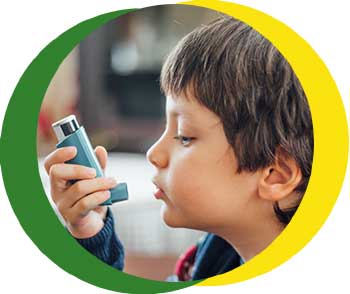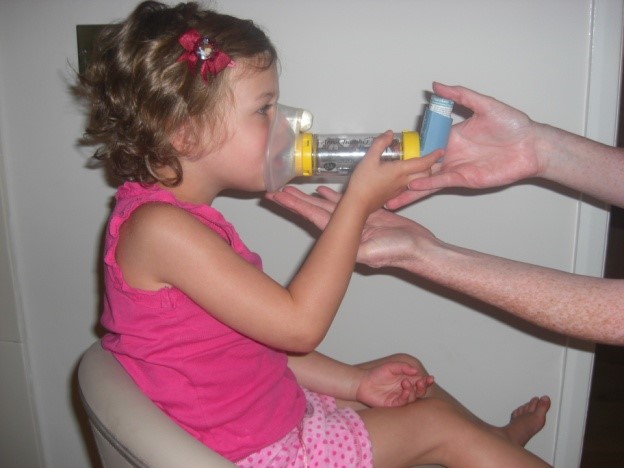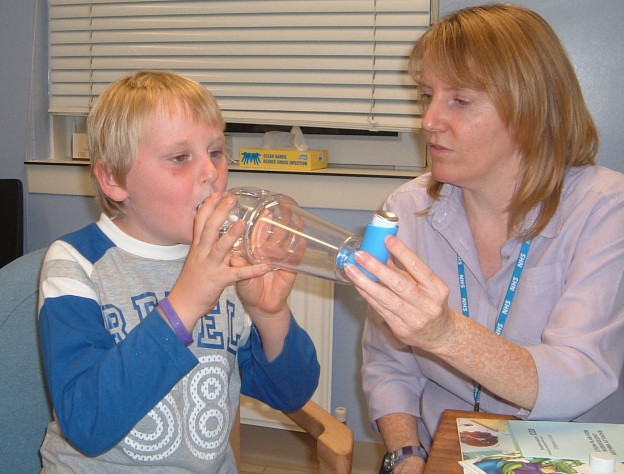Asthma attack

If your child’s asthma suddenly get much worse (asthma attack), they will require urgent treatment. Signs of an asthma attack include:
- Being very wheezy
- Having a tight chest
- Finding it hard to breath
- Being too breathless to speak is a sign of a severe asthma attack and needs emergency treatment
Looking after your child during an asthma attack
Sometimes there is no obvious cause for your child’s asthma attack, but the most common triggers are viral infections (coughs, colds and chest infections), sudden changes in the weather and exposure to cigarette smoke.
If you are concerned about your child’s symptoms please see the table below.
Operation Ouch – Asthma
When should you worry?
If your child is:
- Too breathless to talk / eat or drink
- Has blue lips
- Having symptoms of cough/wheeze or breathlessness which are getting worse despite 10 puffs blue (salbutamol) inhaler every 4 hours
- Confused and drowsy.
Ring 999 immediately for help. Give 10 puffs of blue (salbutamol) reliever inhaler every 10 minutes until ambulance arrives
Keep child in upright position and reassure them
If your child is:
- Wheezing and breathless and blue (salbutamol) reliever inhaler 2-5 puffs is not lasting 4 hours
- Having a cough or wheeze/tight chest during the day and night
- Too breathless to run / play / do normal activities
Immediately contact your GP and make an appointment for your child to be seen that day face to face
Increase blue (salbutamol) reliever inhaler 6-10 puffs every 4 hours
We recognise that at peak times, access to a health care professional may be delayed. If symptoms persist for 4 hours or more and you have not been able to speak to either a member of staff from your GP practice or to NHS 111 staff, then consider taking them to your nearest Emergency Department
Your child’s asthma is good if:
- Have no cough
- Have no wheeze
- Can play or exercise as usual
- Are sleeping well
- Are going to school
To keep the asthma under control, you need to take your treatment every day
What can you do to reduce the risk of your child having another asthma attack?
1) Children with poorly controlled asthma are much more likely to have an asthma attack compared to children whose asthma is well controlled.
Signs of poorly controlled asthma include your child having a regular cough at night (nocturnal cough), being wheezy or more breathless than other children when they run around (exertional dyspnoea) or using their reliever inhaler more often than expected.
Arrange to see your GP or asthma nurse if they are experiencing such symptoms.
To watch a video on encouraging children to use their inhalers effectively.
2) It is vital that your child uses their inhalers correctly.
Your child’s asthma will not be controlled if their medicines are not getting into their lungs.

Choose appropriate sized spacer with mask (or mouthpiece if child is over 3 years with good technique and is not significantly short of breath).
- Shake the inhaler well and remove cap
- Fit the inhaler into the opening at the end of the spacer
- Place mask over the child’s face or mouthpiece in their mouth ensuring a good seal
- Press the inhaler once and allow the child to take 5 slow breaths or slow count to 10 between ease dose
- Remove the inhaler and shake between every puff. Wait 1 minute between puffs

Repeat steps 1-5 for subsequent doses.
Plastic spacers should be washed before 1st use and every month as per manufacturer’s guidelines.
For videos on using your child’s inhaler and spacer correctly see goo.gl/235DQ
See your practice nurse or doctor if you are not sure whether your child is using their inhaler properly.
3) Avoid triggers where possible:
Although it is extremely difficult to avoid your child getting a viral infection or experiencing changes in the weather, you can reduce exposure to common irritants such as cigarette smoke. Even where adults smoke away from their children, smoke on their clothes and hair is likely to make their child’s asthma worse.
4) Your child should have an influenza (flu) immunisation every autumn
Not only can the flu trigger an asthma attack in your child, your child is more likely to experience severe influenza if they have asthma. Protect them by having them vaccinated every year.
What should you do?
At the start of cold symptoms (such as runny nose), begin your child on blue (salbutamol) reliever inhaler 2 puffs 4 hourly (including through the night). This can be increased to up to 10 puffs at a time if your child’s symptoms are still significant. If your child is requiring increasing amounts of blue inhaler you should seek medical advice according to the table below.
Treatment over the next few days
Over the next few days, your child will given a blue (salbutamol) reliever inhaler and you need to take 2-4 puffs of your reliever (1 puff at a time) every 4 hours using the spacer
Download the asthma care plan to support your child’s asthma.
Where should you seek help?
- If it is non-urgent, speak to your local pharmacist or health visitor.
- If your child has any of the above features, urgently see your GP. For an urgent out-of-hours GP appointment, call NHS 111.
- You should only call 999 or go your nearest A&E department in critical or life threatening situations.

